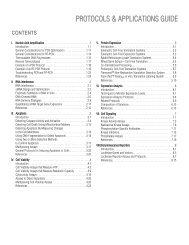2012 Promega catalogue
2012 Promega catalogue
2012 Promega catalogue
You also want an ePaper? Increase the reach of your titles
YUMPU automatically turns print PDFs into web optimized ePapers that Google loves.
Cell Signaling<br />
Asp-N, Sequencing Grade<br />
Product Size Cat.# Price ($)<br />
Asp-N, Sequencing Grade 2 µg V1621 216.00<br />
For Research Use Only. Not for Use in Diagnostic Procedures.<br />
Description: Asp-N, Sequencing Grade, is an endoproteinase that hydrolyzes<br />
peptide bonds on the N-terminal side of aspartic and cysteic acid residues: Asp<br />
and Cys. Asp-N activity is optimal in the pH range of 4.0–9.0. This sequencing<br />
grade enzyme can be used alone or in combination with other proteases to<br />
produce protein digests for peptide mapping applications or protein identification<br />
by peptide mass fingerprinting or MS/MS spectral matching. It is suitable<br />
for digestion reactions in solution or in gel.<br />
Storage Conditions: Store at 4°C.<br />
Protocol Part#<br />
Asp-N Sequencing Grade Product Information 9PIV162<br />
Glu-C, Sequencing Grade<br />
Product Size Cat.# Price ($)<br />
Glu-C, Sequencing Grade<br />
For Research Use Only. Not for Use in Diagnostic Procedures.<br />
50 µg V1651 226.00<br />
Description: Glu-C, Sequencing Grade (S. aureus V8), is a serine protease that<br />
specifically cleaves at the C-terminus of aspartic or glutamic acid residues. In<br />
ammonium bicarbonate and ammonium acetate the enzyme specificity is higher<br />
at the glutamic residues. In phosphate buffers cleavage occurs at the aspartic<br />
and glutamic residues. Glu-C activity is optimal in the pH range of 4.0–9.0.<br />
This sequencing grade enzyme can be used alone or in combination with other<br />
proteases to produce protein digests for peptide mapping applications or protein<br />
identification by peptide mass fingerprinting or MS/MS spectral matching. It<br />
is suitable for digestion reactions in solution but not recommended for in-gel<br />
digestions.<br />
Storage Conditions: Store at 2–10°C.<br />
Protocol Part#<br />
Glu-C Sequencing Grade Product Information 9PIV165<br />
Proteinase K<br />
For complete and up-to-date product information visit: www.promega.com/catalog<br />
Product Size Cat.# Price ($)<br />
Proteinase K<br />
For Research Use Only. Not for Use in Diagnostic Procedures.<br />
100 mg V3021 156.00<br />
Description: Proteinase K, produced by the fungus Tritirachium album Limber,<br />
is a serine protease that exhibits broad cleavage activity. It cleaves peptide<br />
bonds adjacent to the carboxylic group of aliphatic and aromatic amino acids<br />
and is useful for general digestion of protein in biological samples. It has been<br />
purified to remove RNase and DNase activities. The stability of Proteinase K<br />
in urea and SDS and its ability to digest native proteins make it useful for a<br />
variety of applications including preparation of chromosomal DNA for pulsedfield<br />
gel electrophoresis, protein fingerprinting and removal of nucleases from<br />
preparations of DNA and RNA. A typical working concentration for Proteinase K<br />
is 50–100μg/ml.<br />
Form: Lyophilized powder.<br />
Recommended Reaction Buffer: 50mM Tris-HCl (pH 8.0), 10mM CaCl 2.<br />
Features:<br />
• Stable: Active over a pH range of 4.3–12.0, in 0.5% SDS or 1% Triton ®<br />
X-100 and retains >80% of its activity at temperatures up to 60°C.<br />
Storage Conditions: Store lyophilized powder desiccated at –20°C.<br />
Protocol Part#<br />
Proteinase K Product Information 9PIV302<br />
Factor Xa Protease<br />
Product Size Cat.# Price ($)<br />
Factor Xa Protease<br />
For Research Use Only. Not for Use in Diagnostic Procedures.<br />
50 µg V5581 241.00<br />
Description: Factor Xa Protease is purified from bovine plasma and activated<br />
by treatment with the activating enzyme from Russell’s viper venom. Factor<br />
Xa Protease preferentially cleaves after the arginine residue in the amino acid<br />
sequence Ile-Glu-Gly-Arg.<br />
Recommended Reaction Buffer: 20mM Tris-HCl (pH 7.4), 0.1M NaCl.<br />
Storage Conditions: Store in aliquots at –20°C.<br />
233<br />
13<br />
Protein Expression and Analysis<br />
Section<br />
Contents<br />
Table of<br />
Contents
















